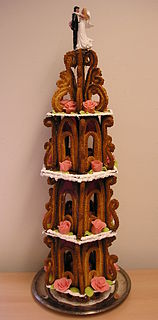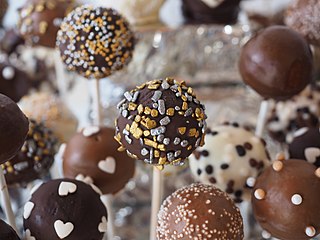
A cookie is a baked or cooked snack or dessert that is typically small, flat and sweet. It usually contains flour, sugar, egg, and some type of oil, fat, or butter. It may include other ingredients such as raisins, oats, chocolate chips, nuts, etc.

Confectionery is the art of making confections, which are food items that are rich in sugar and carbohydrates. Exact definitions are difficult. In general, however, confectionery is divided into two broad and somewhat overlapping categories: bakers' confections and sugar confections. The occupation of confectioner encompasses the categories of cooking performed by both the French patissier and the confiseur.

Cake is a flour confection made from flour, sugar, and other ingredients, and is usually baked. In their oldest forms, cakes were modifications of bread, but cakes now cover a wide range of preparations that can be simple or elaborate, and which share features with desserts such as pastries, meringues, custards, and pies.

A wedding cake is the traditional cake served at wedding receptions following dinner. In some parts of England, the wedding cake is served at a wedding breakfast; the 'wedding breakfast' does not mean the meal will be held in the morning, but at a time following the ceremony on the same day. In modern Western culture, the cake is usually on display and served to guests at the reception. Traditionally, wedding cakes were made to bring good luck to all guests and the couple. Nowadays, however, they are more of a centerpiece to the wedding and are not always even served to the guests. Some cakes are built with only a single edible tier for the bride and groom to share, but this is rare since the cost difference between fake and real tiers is minimal.

Icing, or frosting, is a sweet, often creamy glaze made of sugar with a liquid, such as water or milk, that is often enriched with ingredients like butter, egg whites, cream cheese, or flavorings. It is used to coat or decorate baked goods, such as cakes. When it is used between layers of cake it is known as a filling.

A macaroon is a small cake or biscuit, typically made from ground almonds, coconut or other nuts, with sugar and sometimes flavourings, food colouring, glacé cherries, jam or a chocolate coating; or a combination of these or other ingredients. Some recipes use sweetened condensed milk. Macaroons are sometimes baked on edible rice paper placed on a baking tray.

Fruitcake is a cake made with candied or dried fruit, nuts, and spices, and optionally soaked in spirits. In the United Kingdom, certain rich versions may be iced and decorated.

Gingerbread refers to a broad category of baked goods, typically flavored with ginger, cloves, nutmeg, and cinnamon and sweetened with honey, sugar, or molasses. Gingerbread foods vary, ranging from a soft, moist loaf cake to something close to a ginger snap.

A mille-feuille, also known by the names Napoleon, vanilla slice, and custard slice, is a dessert made of puff pastry layered with pastry cream. Its modern form was influenced by improvements made by Marie-Antoine Carême.

Sugar candy is any candy whose primary ingredient is sugar. The main types of sugar candies are hard candies, fondants, caramels, jellies, and nougats. In British English, this broad category of sugar candies is called sweets, and the name candy or sugar-candy is used only for hard candies that are nearly solid sugar.

Fondant icing, also commonly referred to simply as fondant, is an icing used to decorate or sculpt cakes and pastries. It is made from sugar, water, gelatin, vegetable fat or shortening, and glycerol. It does not have the texture of most icings; rolled fondant is akin to stiff clay, while poured fondant is a thick liquid. The word, in French, means "melting," coming from the same root as fondue and foundry.

Molten chocolate cake is a popular dessert that combines the elements of a chocolate cake and a soufflé. Its name derives from the dessert's liquid chocolate center, and it is also known as chocolate moelleux, chocolate lava cake, or simply lava cake. It should not be confused with chocolate fondant, a recipe that contains little flour, but much chocolate and butter, hence melting on the palate. It is a type of self-saucing pudding.

Royal icing is a hard white icing, made from softly beaten egg whites, icing sugar, and sometimes lemon or lime juice. It is used to decorate Christmas cakes, wedding cakes, gingerbread houses, cookies and many other cakes and biscuits. It is used either as a smooth covering or in sharp peaks. Glycerine is often added to prevent the icing from setting too hard. When placing icing on cakes, marzipan is usually used under the royal icing in order to prevent discoloration of the icing.

Sugar sculpture is the art of producing artistic centerpieces entirely composed of sugar and sugar derivatives. These were very popular at grand feasts from the Renaissance until at least the 18th century, and sometimes made by famous artists. Today, there are many competitions that include sugar sculpture.

Cake decorating is the art of dressing up of a cake for special occasions such as birthdays, weddings, national or religious holidays, or as a promotional good for a business. It is a form of sugar art that uses manipulation like icing, frosting, fondant, and other edible decorate can be consumed. Cake decorating can go beyond the simple art of dressing up a cake. There are cake decorators who have honed their skills in creating art from cake decorating: TV channels such as TLC, Food Network and Discovery Family have featured artisan bakers. They give us a glimpse into how the cake may be molded during baking or sculpted after baking. It may take on simple or elaborate three-dimensional shapes as part of its decoration or as its entirety. Chocolate is commonly used to decorate a cake. It can be melted and mixed with cream to make a ganache or cocoa powder can be lightly dusted on top of a cake.

Cookie decorating dates back to at least the 14th century when in Switzerland, springerle cookie molds were carved from wood and used to impress Biblical designs into cookies.
Icingtons are traditional wedding figurines made entirely of icing sugar. Icingtons are distinguishable from other wedding figurines by their organic soft look. They are placed on top of the wedding cake as a visual and symbolic mechanism.

A cake pop is a form of cake styled as a lollipop. Cake crumbs are mixed with icing or chocolate, and formed into small spheres or cubes in the same way as cake balls, before being given a coating of icing, chocolate or other decorations and attached to lollipop sticks. Cake pops can be a way of using up leftover cake or cake crumbs.
Fondant is a mixture of sugar and water used as a confection, filling, or icing. Sometimes gelatin and glycerine are used as softeners and/or stabilizers.

Chef Nicholas Lodge was a pastry chef, master cake artist, author and instructor. He was the co-owner of the Atlanta-based International Sugar Art Collection, a retail gallery and school teaching all levels of cake decorating and sugar arts. He was best known for creating botanically correct gum paste flowers. Lodge was an instructor at the French Pastry School in Chicago, Illinois. He was a recurring judge on Food Network Challenge, he judged annually at the Omni Grove Park Inn National Gingerbread House Competition and other regional competitions.


















